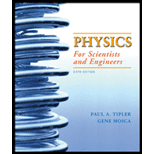
Concept explainers
(a)
The potential on the
(a)
Answer to Problem 88P
The potential on the
Explanation of Solution
Formula used:
The expression for potential due to the ring is given by,
The potential due to the ring is the sum of the charges due to charge on the left and right is given by,
Calculation:
The potential due to the ring on the left side is written as,
The potential due to the ring on the right side is written as,
The potential due to the ring is calculated as,
Therefore, the potential on the
(b)
The position for the minimum value of
(b)
Answer to Problem 88P
The position for the minimum value of
Explanation of Solution
Calculation:
Differentiatethe potential of the ring.
Solving for
Evaluating
Evaluating this expression for
The above expression implies
Conclusion:
Therefore,
(c)
The potential for
(c)
Answer to Problem 88P
The potential for
Explanation of Solution
Formula used:
The Taylor series expansion of
Calculation:
For
The potential is calculated as,
Conclusion:
Therefore,the potential for
(d)
The angular frequency of oscillation.
(d)
Answer to Problem 88P
The angular frequency of oscillation is
Explanation of Solution
Formula used:
The expression for the angular frequency of oscillation of a simple harmonic oscillator is given by,
The expression for the potential energy is given by,
Calculation:
The energy is calculated as,
Here,
The angular frequency is then calculated as,
Conclusion:
Therefore,the angular frequency of oscillation is
Want to see more full solutions like this?
Chapter 23 Solutions
EBK PHYSICS FOR SCIENTISTS AND ENGINEER
- 8. With the aid of a diagram draw the following electric circuit and use the resistor as the load, (a) Closed circuit (b) Open circuitarrow_forwardLab 8 Part 3 PHET Wave Interface simulation. I am having trouble with this part of the lab.arrow_forwardMick and Rick are twins born on Earth in the year 2175. Rick grows up to be an Earth-bound robotics technician while Mick becomes an intergalactic astronaut. Mick leaves the Earth on his first space mission in the year 2200 and travels, according to his clock, for 10 years at a speed of 0.75c. Unfortunately, at this point in his journey, the structure of his ship undergoes mechanical breakdown and the ship explodes. How old is Rick when his brother dies?arrow_forward
 Physics for Scientists and Engineers: Foundations...PhysicsISBN:9781133939146Author:Katz, Debora M.Publisher:Cengage Learning
Physics for Scientists and Engineers: Foundations...PhysicsISBN:9781133939146Author:Katz, Debora M.Publisher:Cengage Learning Principles of Physics: A Calculus-Based TextPhysicsISBN:9781133104261Author:Raymond A. Serway, John W. JewettPublisher:Cengage Learning
Principles of Physics: A Calculus-Based TextPhysicsISBN:9781133104261Author:Raymond A. Serway, John W. JewettPublisher:Cengage Learning College PhysicsPhysicsISBN:9781285737027Author:Raymond A. Serway, Chris VuillePublisher:Cengage Learning
College PhysicsPhysicsISBN:9781285737027Author:Raymond A. Serway, Chris VuillePublisher:Cengage Learning Physics for Scientists and Engineers, Technology ...PhysicsISBN:9781305116399Author:Raymond A. Serway, John W. JewettPublisher:Cengage Learning
Physics for Scientists and Engineers, Technology ...PhysicsISBN:9781305116399Author:Raymond A. Serway, John W. JewettPublisher:Cengage Learning
 College PhysicsPhysicsISBN:9781305952300Author:Raymond A. Serway, Chris VuillePublisher:Cengage Learning
College PhysicsPhysicsISBN:9781305952300Author:Raymond A. Serway, Chris VuillePublisher:Cengage Learning





